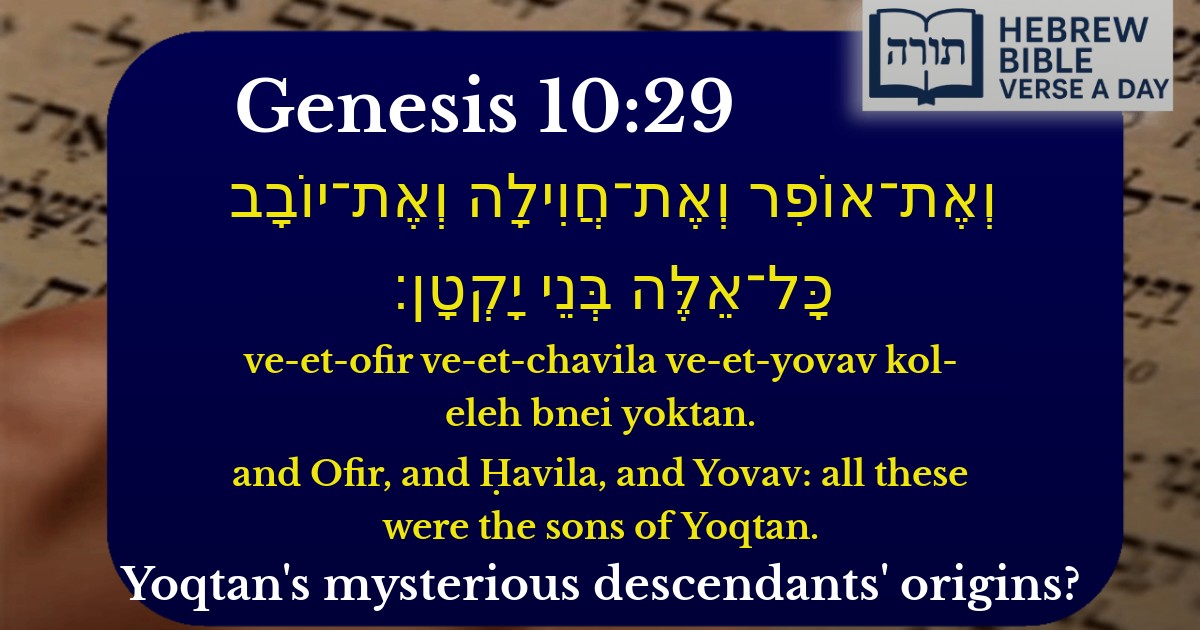Frequently Asked Questions
Q: Who were the sons of Yoqtan mentioned in Genesis 10:29?
A: The sons of Yoqtan—Ofir, Ḥavila, and Yovav—were descendants of Shem, one of Noaḥ's sons. According to Rashi, these names refer to regions or nations that descended from Yoqtan. For example, Ḥavila is associated with a land known for its precious resources (see Genesis 2:11).
Q: Why is the lineage of Yoqtan important in the Torah?
A: The Torah traces lineages to show the origins of nations and highlight key figures in Jewish history. Yoqtan's descendants settled in Arabia, as noted by Ramban (Nachmanides). Understanding these lineages helps us see how different nations emerged from Noaḥ's family after the flood.
Q: What can we learn from the mention of Yoqtan's sons in Genesis 10:29?
A: This verse teaches us the importance of family and ancestry in the Torah. The detailed lists of descendants emphasize that every nation has a Divine purpose. The Midrash (Bereishit Rabbah) often explores how these lineages shape history and Jewish identity.
Q: Are the places Ofir and Ḥavila mentioned elsewhere in the Torah?
A: Yes, Ḥavila appears earlier in Genesis (2:11) as a land with gold and precious stones. Ofir is later referenced (e.g., in Melachim I 9:28) as a source of fine gold. These connections show how Torah geography links generations and events.
Q: How does this verse apply to us today?
A: While we may not trace our lineage directly to Yoqtan, the Torah's emphasis on ancestry reminds us of our roots and shared humanity. Jewish tradition values knowing our heritage, as it shapes our identity and connection to Hashem’s plan for the world.


Context in Sefer Bereishit
This verse appears in Bereishit 10:29 as part of the genealogy of the descendants of Shem, specifically listing the sons of Yoktan (Yoqtan), who was a descendant of Eber and an ancestor of various Arabian tribes. The Torah enumerates these names to trace the origins of nations following the dispersion at Migdal Bavel (Tower of Babel).
Rashi's Commentary
Rashi (Bereishit 10:29) notes that Yoktan was a righteous man, as his name suggests ("small" or "humble"), indicating his humility before Hashem. Rashi also connects these names to geographical locations known in his time:
Midrashic Interpretations
The Midrash Rabbah (Bereishit Rabbah 37:6) elaborates that Yoktan's descendants settled in the southern Arabian Peninsula. The names Ofir and Chavila are tied to material wealth, symbolizing the prosperity of these regions. The Midrash also emphasizes that these genealogies highlight Hashem's providence in assigning lands to each nation after the dispersion.
Rambam's Perspective
In Moreh Nevuchim (1:42), Rambam discusses how the Torah records the origins of nations to establish the uniqueness of Avraham's lineage. The mention of Yoktan's sons underscores the diversity of human settlement while setting the stage for the eventual selection of Avraham's descendants as the chosen people.
Historical and Geographical Significance
Traditional Jewish sources, such as Seder Olam Rabbah, identify these names with ancient trading regions. Ofir, for example, was renowned in Tanach as a source of gold for Shlomo HaMelech's Temple (Melachim I 9:28). Chavila is similarly associated with wealth, reinforcing the idea that these tribes inhabited resource-rich areas.